El Niño-Southern Oscillation and Indian Ocean Dipole Modes: Their Effects on South American Rainfall during Austral Spring
Abstract
:1. Introduction
2. Materials and Methods
3. Results
3.1. Austral Spring Rainfall: Climatology and Standard Deviation
3.2. EOF Modes of the SST Anomalies in the Tropical Pacific and TIO
3.3. Residual TPO Composites
3.4. Residual IOD Composites
4. Discussions and Conclusions
Author Contributions
Funding
Institutional Review Board Statement
Informed Consent Statement
Data Availability Statement
Conflicts of Interest
References
- Zhou, J.; Lau, K.M. Principal modes of interannual and decadal variability of summer rainfall over South America. Int. J. Climatol. 2001, 21, 1623–1644. [Google Scholar] [CrossRef]
- Mo, K.C.; Higgins, R.W. The Pacific-South American modes and tropical convection during the Southern Hemisphere winter. Mon. Weather Rev. 1998, 126, 1581–1596. [Google Scholar] [CrossRef]
- Paegle, J.N.; Mo, K.C. Linkages between summer rainfall variability over South America and sea surface temperature anomalies. J. Clim. 2002, 15, 1389–1407. [Google Scholar] [CrossRef] [Green Version]
- Ropelewski, C.F.; Halpert, M.S. Global and Regional scale precipitation patterns associated with the El Niño-Southern Oscillation. Mon. Weather Rev. 1987, 115, 1606–1626. [Google Scholar] [CrossRef] [Green Version]
- Kousky, V.E.; Ropelewski, C.F. Extremes in the Southern Oscillation and their Relationship to Precipitation Anomalies with Emphasis on the South American Region. Rev. Bras. Meteorol. 1989, 4, 351–363. [Google Scholar]
- Aceituno, P. On the Functioning of the Southern Oscillation in the South American Sector. Part I: Surface Climate. Mon. Weather Rev. 1988, 116, 505–524. [Google Scholar] [CrossRef] [Green Version]
- Kayano, M.T.; Rao, V.B.; Moura, A.D. Tropical circulations and the associated rainfall anomalies during two contrasting years. J. Climatol. 1988, 8, 477–488. [Google Scholar] [CrossRef] [Green Version]
- Rao, V.B.; Hada, K. Characteristics of rainfall over Brazil: Annual variations and connections with the Southern Oscillation. Theor. Appl. Climatol. 1990, 42, 81–91. [Google Scholar] [CrossRef]
- Grimm, A.M. Interannual climate variability in South America: Impacts on seasonal precipitation, extreme events, and possible effects of climate change. Stoch. Environ. Res. Risk Assess. 2011, 25, 537–554. [Google Scholar] [CrossRef]
- Grimm, A.M.; Zilli, M.T. Interannual variability and seasonal evolution of summer monsoon rainfall in South America. J. Clim. 2009, 22, 2257–2275. [Google Scholar] [CrossRef]
- De Souza, I.P.; Andreoli, R.V.; Kayano, M.T.; Vargas, F.F.; Cerón, W.L.; Martins, J.A.; Freitas, E.; de Souza, R.A.F. Seasonal precipitation variability modes over South America associated to El Niño-Southern Oscillation (ENSO) and non-ENSO components during the 1951–2016 period. Int. J. Climatol. 2021, 41, 4321–4338. [Google Scholar] [CrossRef]
- Grimm, A.M.; Ferraz, S.E.T.; Gomes, J. Precipitation Anomalies in Southern Brazil Associated with El Niño and La Niña Events. J. Clim. 1998, 11, 2863–2880. [Google Scholar] [CrossRef] [Green Version]
- Taschetto, A.S.; Ambrizzi, T. Can Indian Ocean SST anomalies influence South American rainfall? Clim. Dyn. 2012, 38, 1615–1628. [Google Scholar] [CrossRef] [Green Version]
- Kayano, M.T.; Andreoli, R.V.; Cerón, W.L.; Souza, R.A.F. The Role of the Indian Ocean Basin-Wide and El Niño—Southern Oscillation Modes in Interannual Rainfall Variability over South America during Austral Summer. Atmosphere 2021, 12, 1094. [Google Scholar] [CrossRef]
- Saji, N.H.; Goswani, B.N.; Vinayachandran, P.N.; Yamagat, T. A dipole mode in the tropical Indian Ocean. Nature 1999, 401, 360–363. [Google Scholar] [CrossRef] [PubMed]
- Klein, S.A.; Soden, B.J.; Lau, N.-C. Remote Sea Surface Temperature Variations during ENSO: Evidence for a Tropical Atmospheric Bridge. J. Clim. 1999, 12, 917–932. [Google Scholar] [CrossRef] [Green Version]
- Deser, C.; Alexander, M.A.; Xie, S.P.; Phillips, A.S. Sea surface temperature variability: Patterns and mechanisms. Annu. Rev. Mar. Sci. 2010, 2, 115–143. [Google Scholar] [CrossRef] [PubMed] [Green Version]
- Lim, E.P.; Hendon, H.H. Causes and Predictability of the Negative Indian Ocean Dipole and Its Impact on la Niña during 2016. Sci. Rep. 2017, 7, 1–11. [Google Scholar] [CrossRef] [Green Version]
- Lau, N.C.; Nath, M.J. Atmosphere-ocean variations in the Indo-Pacific sector during ENSO episodes. J. Clim. 2003, 16, 3–20. [Google Scholar] [CrossRef]
- Wang, X.; Wang, C. Different impacts of various El Niño events on the Indian Ocean Dipole. Clim. Dyn. 2014, 42, 991–1005. [Google Scholar] [CrossRef]
- Sun, S.; Lan, J.; Yue Fang, T.; Gao, X. A triggering mechanism for the Indian Ocean dipoles independent of ENSO. J. Clim. 2015, 28, 5063–5076. [Google Scholar] [CrossRef]
- Webster, P.J.; Moore, A.M.; Loschnigg, J.P.; Leben, R.R. Coupled ocean-atmosphere dynamics in the Indian Ocean during 1997–98. Nature 1999, 401, 356–360. [Google Scholar] [CrossRef] [PubMed]
- Annamalai, H.; Xie, S.P.; McCreary, J.P.; Murtugudde, R. Impact of Indian Ocean Sea surface temperature on developing El Niño. J. Clim. 2005, 18, 302–320. [Google Scholar] [CrossRef]
- Xie, S.P.; Hu, K.; Hafner, J.; Tokinaga, H.; Du, Y.; Huang, G.; Sampe, T. Indian Ocean capacitor effect on Indo-Western pacific climate during the summer following El Niño. J. Clim. 2009, 22, 730–747. [Google Scholar] [CrossRef]
- Chan, S.C.; Behera, S.K.; Yamagata, T. Indian Ocean Dipole influence on South American rainfall. Geophys. Res. Lett. 2008, 35, 10–14. [Google Scholar] [CrossRef]
- Saji, N.H.; Ambrizzi, T.; Ferraz, S.E.T. Indian Ocean Dipole mode events and austral surface air temperature anomalies. Dyn. Atmos. Ocean. 2005, 39, 87–101. [Google Scholar] [CrossRef]
- Sena, A.C.T.; Magnusdottir, G. Influence of the Indian Ocean dipole on the large-scale circulation in South America. J. Clim. 2021, 34, 6057–6068. [Google Scholar]
- Wang, H.; Murtugudde, R.; Kumar, A. Evolution of Indian Ocean dipole and its forcing mechanisms in the absence of ENSO. Clim. Dyn. 2016, 47, 2481–2500. [Google Scholar] [CrossRef]
- Yamagata, T.; Behera, S.K.; Luo, J.J.; Masson, S.; Jury, M.R.; Rao, S.A. Coupled ocean-atmosphere variability in the tropical Indian Ocean. Geophys. Monogr. Ser. 2004, 147, 189–211. [Google Scholar]
- Golden Gate Weather Service El Niño and La Niña Years and Intensities. Based on Oceanic Niño Index (ONI). Available online: https://ggweather.com/enso/oni.htm (accessed on 1 September 2021).
- Zhao, Y.; Nigam, S. The Indian Ocean dipole: A monopole in SST. J. Clim. 2015, 28, 3–19. [Google Scholar] [CrossRef] [Green Version]
- Wang, C. Three-ocean interactions and climate variability: A review and perspective. Clim. Dyn. 2019, 53, 5119–5136. [Google Scholar] [CrossRef] [Green Version]
- Huang, B.; Thorne, P.W.; Banzon, V.F.; Boyer, T.; Chepurin, G.; Lawrimore, J.H.; Menne, M.J.; Smith, T.M.; Vose, R.S.; Zhang, H.M. Extended reconstructed Sea surface temperature, Version 5 (ERSSTv5): Upgrades, validations, and intercomparisons. J. Clim. 2017, 30, 8179–8205. [Google Scholar] [CrossRef]
- National Oceanic and Atmospheric Administration; Extended Reconstructed Sea Surface Temperature (NOAA/ERSST) SST data. Available online: https://www.esrl.noaa.gov/psd/data/gridded/ (accessed on 1 March 2018).
- Schneider, U.; Becker, A.; Finger, P.; Meyer-Christoffer, A.; Ziese, M.; Rudolf, B. GPCC’s new land surface precipitation climatology based on quality-controlled in situ data and its role in quantifying the global water cycle. Theor. Appl. Climatol. 2014, 115, 15–40. [Google Scholar] [CrossRef] [Green Version]
- Global Precipitation Climatology Centre (GPCC) Monthly Gridded Precipitation Data. Available online: https://www.esrl.noaa.gov/psd/data/gridded/data.gpcc.html (accessed on 3 May 2019).
- Kalnay, E.; Kanamitsu, M.; Kistler, R.; Collins, W.; Deaven, D.; Gandin, L.; Iredell, M.; Saha, S.; White, G.; Woollen, J.; et al. The NCEP/NCAR reanalysis project. Bull. Am. Meteorol. Soc. 1996, 77, 437–471. [Google Scholar] [CrossRef] [Green Version]
- National Center for Environmental Prediction; National Center for Atmospheric Research (NCEP/NCAR) Reanalysis-I Project Dataset. Available online: https://psl.noaa.gov/data/gridded/ (accessed on 3 September 2020).
- Peixoto, J.P.; Oort, A.H. Physics of Climate; MIT Press: San Diego, CA, USA, 1992; ISBN 7287064. [Google Scholar]
- Torrence, C.; Compo, G.P. A Practical Guide to Wavelet Analysis Christopher. Bull. Am. Meteorol. Soc. 1998, 97, 61–78. [Google Scholar] [CrossRef] [Green Version]
- North, G.L.; Bell, T.L.; Chalan, R.F. Sampling Errors in the Estimation of Empirical Othogonal Functions. Mon. Weather Rev. 1982, 110, 699–706. [Google Scholar] [CrossRef]
- Panofsky, H.G.; Brier, G.W. Some Applications of Statistics to Meteorology; Pennsylvania State University: Pennsylvania, PA, USA, 1968. [Google Scholar]
- Rasmusson, E.M.; Wallace, J.M. Meteorological Aspects of the El Niño/Southern Oscillation. Science 1983, 222, 1195–1202. [Google Scholar] [CrossRef]
- Rasmusson, E.M.; Arkin, P.A. Interannual climate variability associated with the El Niño/Southern Oscillation. Elsevier Oceanogr. Ser. 1985, 40, 697–725. [Google Scholar]
- An, S.I.; Jin, F.F. Nonlinearity and asymmetry of ENSO. J. Clim. 2004, 17, 2399–2412. [Google Scholar] [CrossRef]
- Matsuno, T. Quasi-Geostrophic Motions in the Equatorial Area. J. Meteorol. Soc. Jpn. Ser. II 1966, 44, 25–43. [Google Scholar] [CrossRef] [Green Version]
- Gill, A.E. Some simple solutions for heat-induced tropical circulation. Q. J. R. Meteorol. Soc. 1980, 106, 447–462. [Google Scholar] [CrossRef]
- Liao, H.; Wang, C. Sea Surface Temperature Anomalies in the Western Indian Ocean as a Trigger for Atlantic Niño Events. Geophys. Res. Lett. 2021, 48, e2021GL092489. [Google Scholar] [CrossRef]
- Rasmusson, E.M.; Carpenter, T.H. Variation in tropical sea surface temperature and surface wind fields associated with Southern Oscillation/El Niño. Mon. Weather Rev. 1982, 110, 354–384. [Google Scholar] [CrossRef]
- Ashok, K.; Behera, S.K.; Rao, S.A.; Weng, H.; Yamagata, T. El Niño Modoki and its possible teleconnection. J. Geophys. Res. Ocean. 2007, 112, 1–27. [Google Scholar] [CrossRef]
- Tedeschi, R.G.; Cavalcanti, I.F.A.; Grimm, A.M. Influences of two types of ENSO on South American precipitation. Int. J. Climatol. 2013, 33, 1382–1400. [Google Scholar] [CrossRef]
- Andreoli, R.V.; de Oliveira, S.S.; Kayano, M.T.; Viegas, J.; de Souza, R.A.F.; Candido, L.A. The influence of different El Niño types on the South American rainfall. Int. J. Climatol. 2017, 37, 1374–1390. [Google Scholar] [CrossRef]
- Andreoli, R.V.; Kayano, M.T.; Viegas, J.; de Oliveira, S.S.; de Souza, R.A.F.; Garcia, S.R.; Rego, W.H.T.; de Oliveira, M.B.L. Effects of two different La Niña types on the South American rainfall. Int. J. Climatol. 2019, 39, 1415–1428. [Google Scholar] [CrossRef]
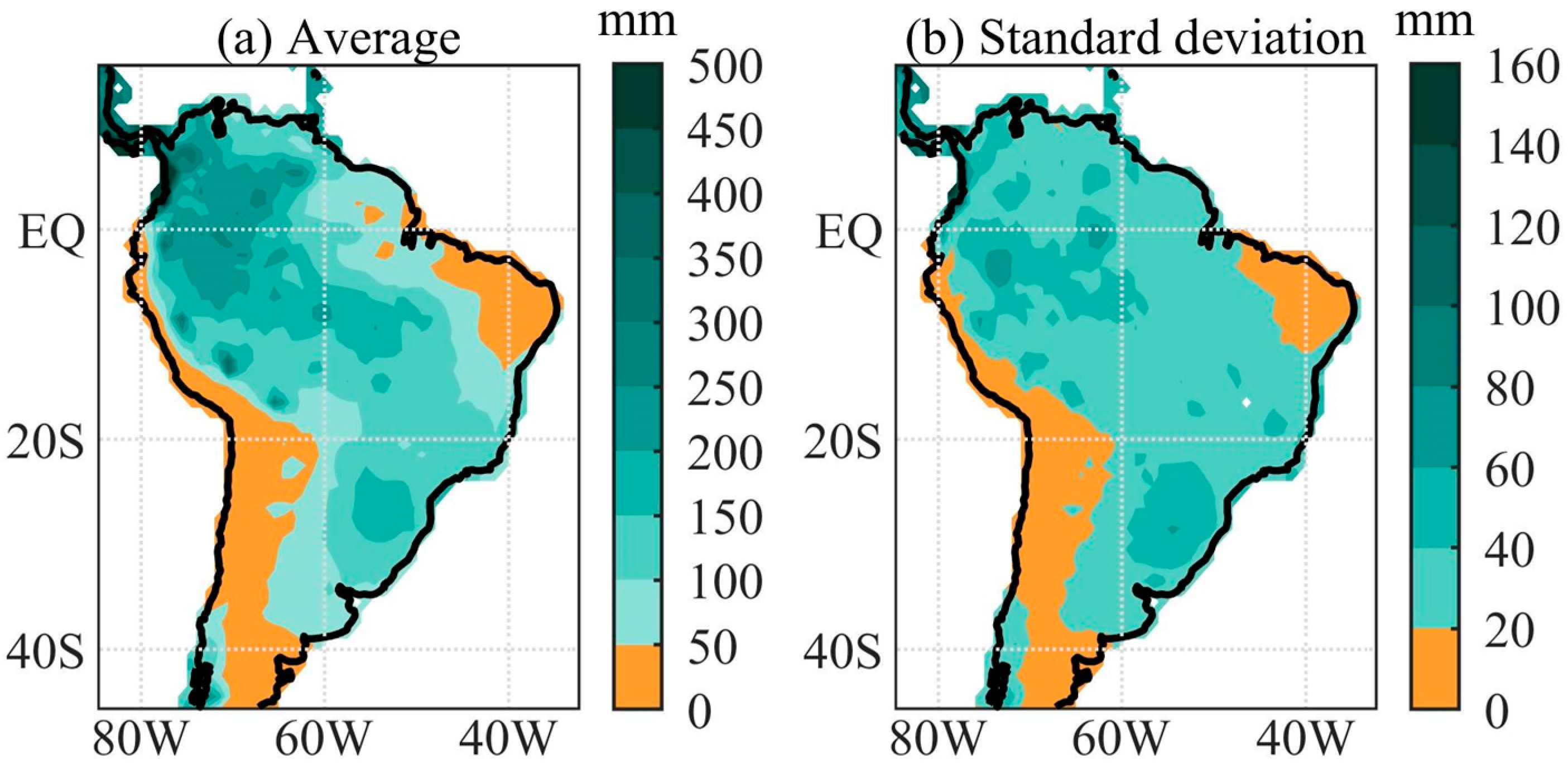

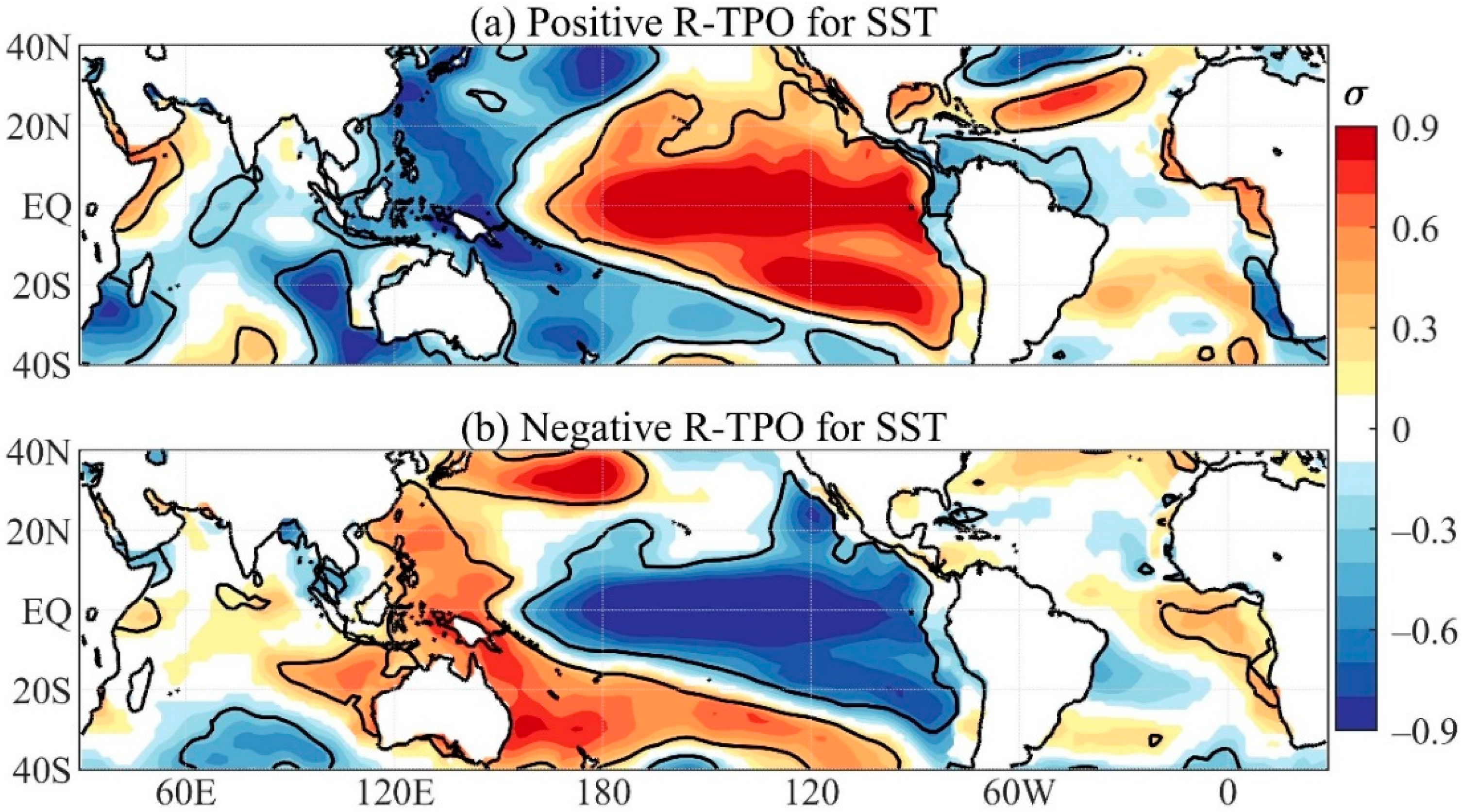
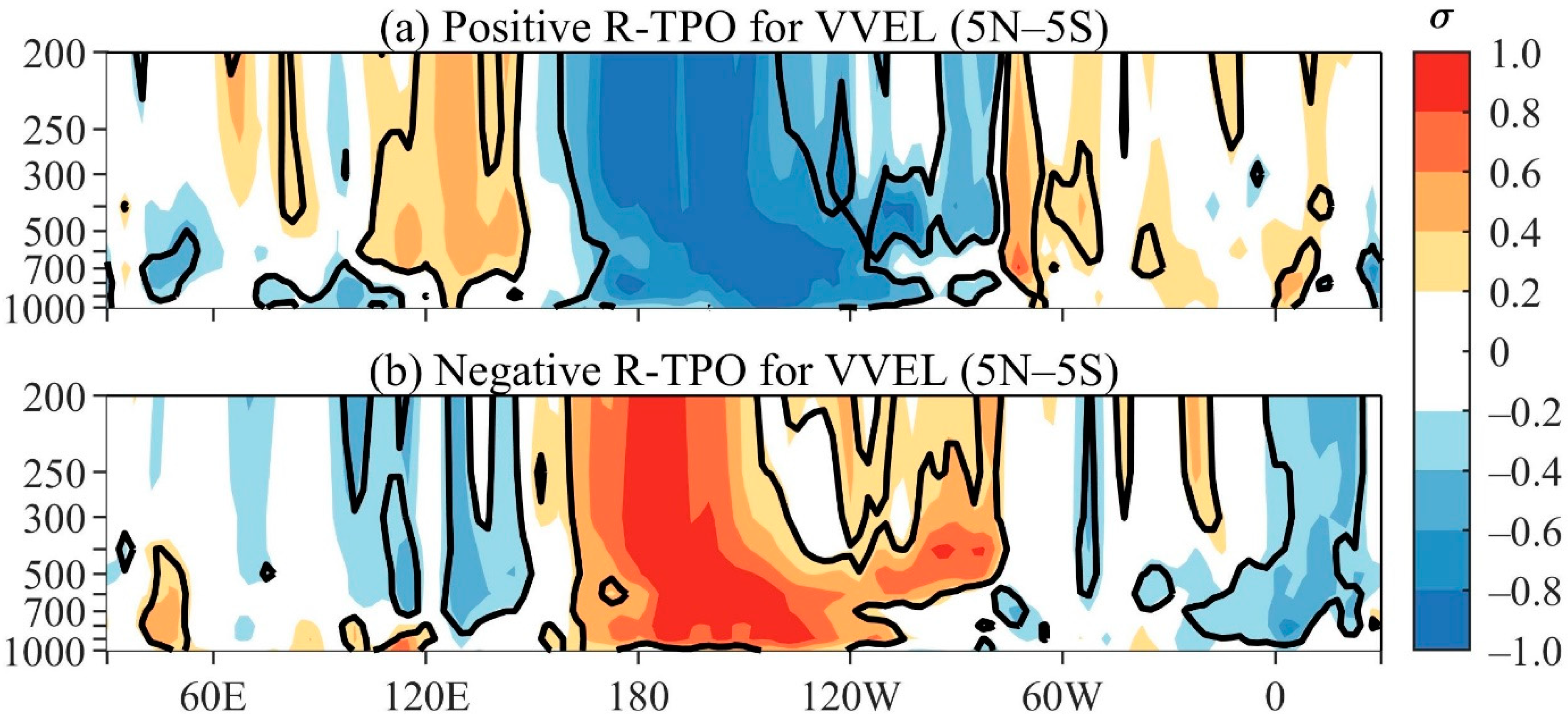
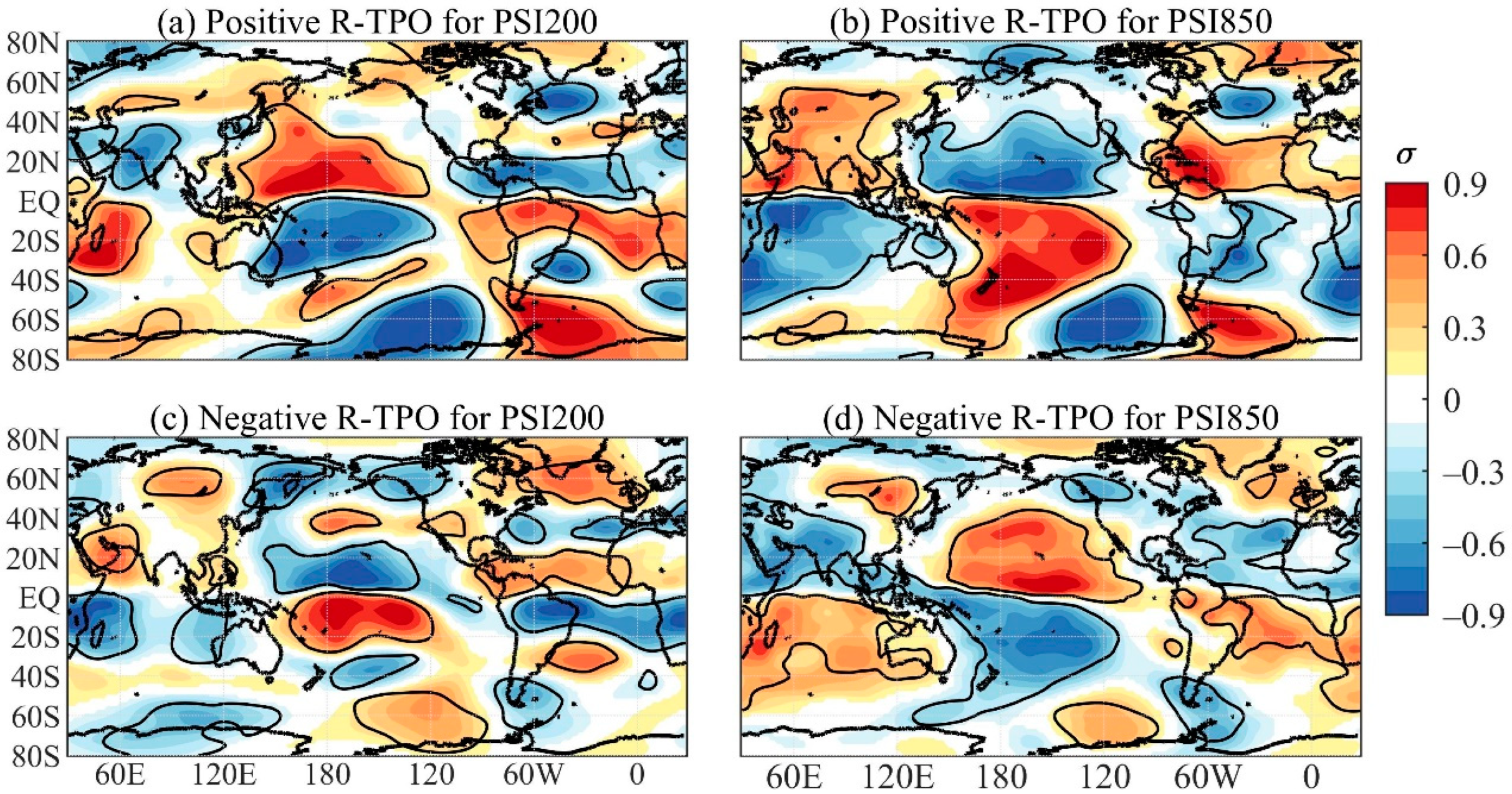
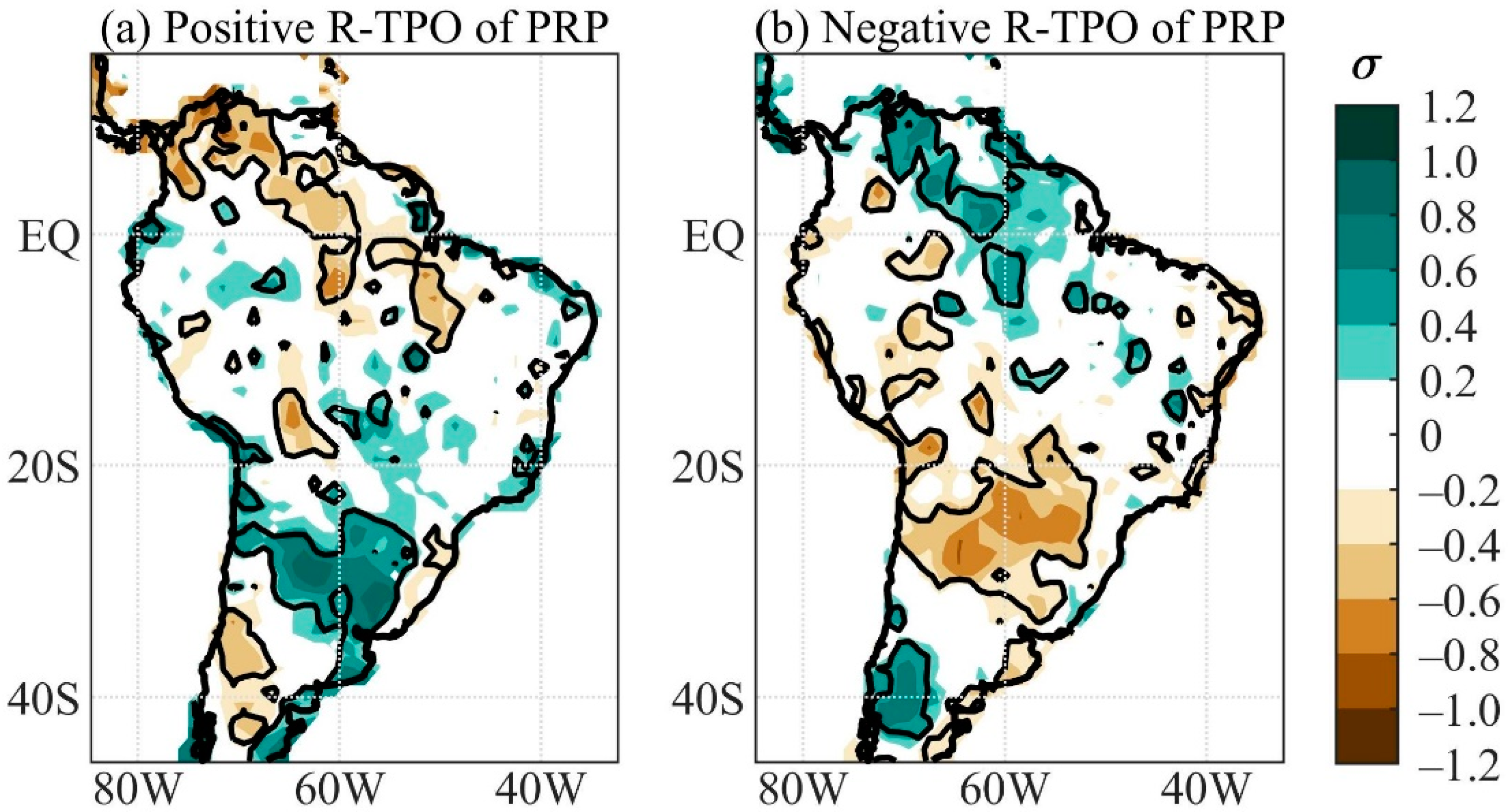
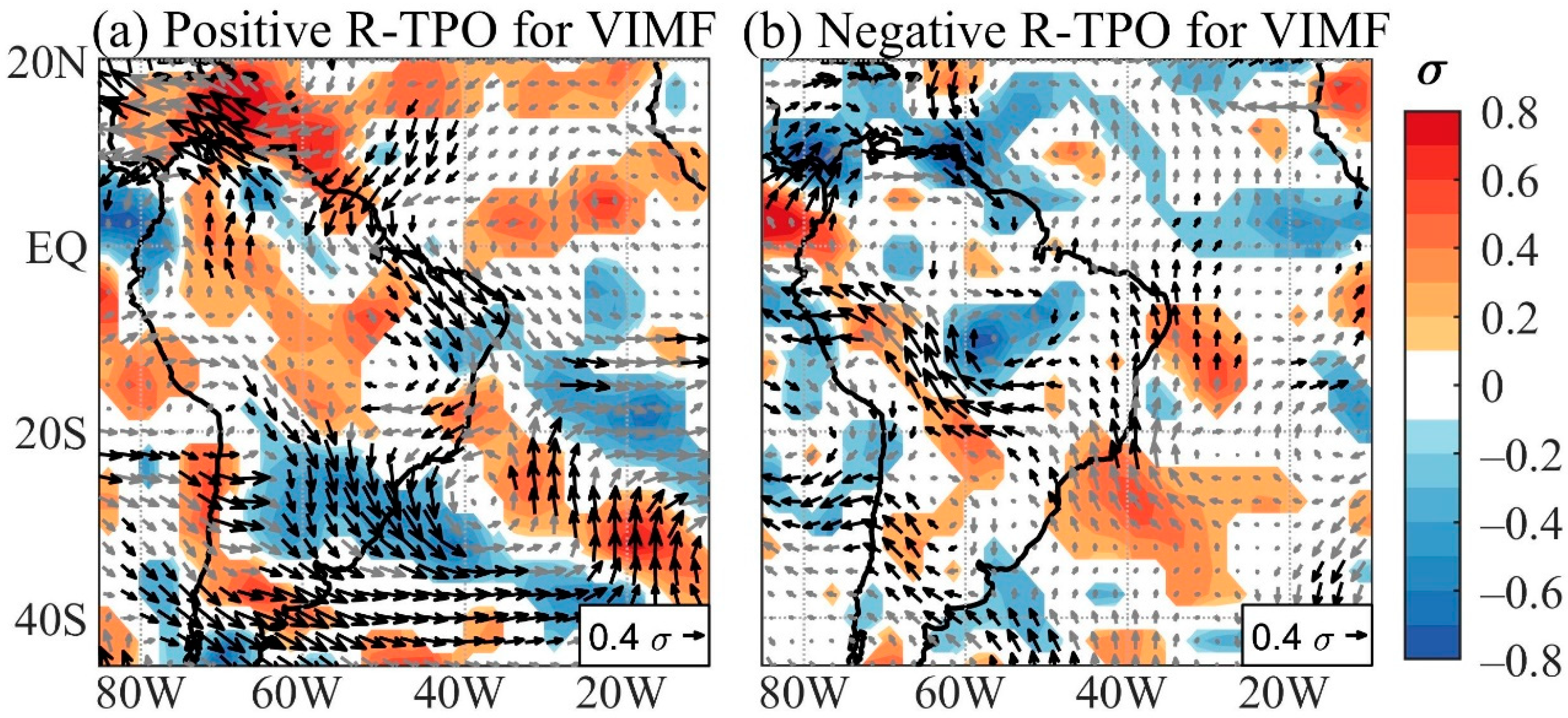

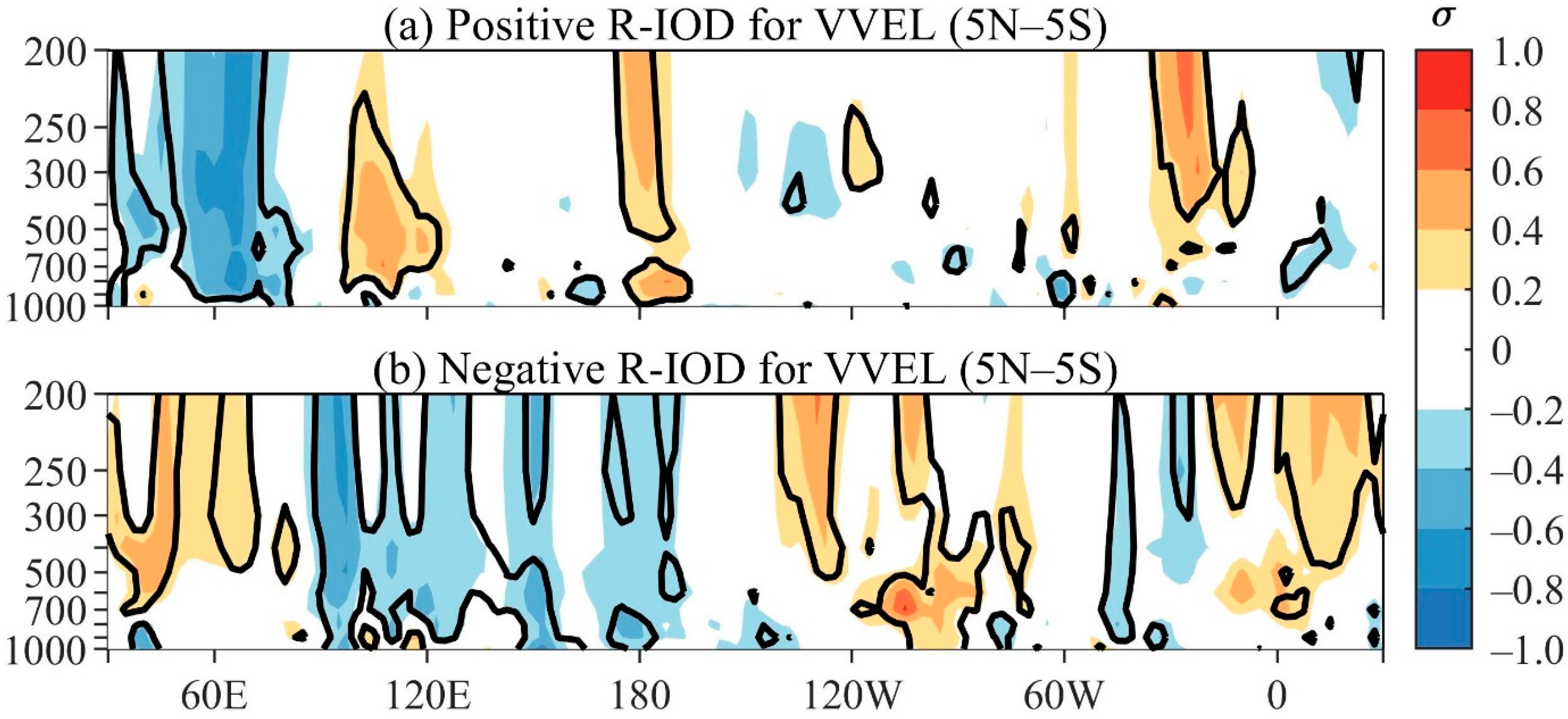
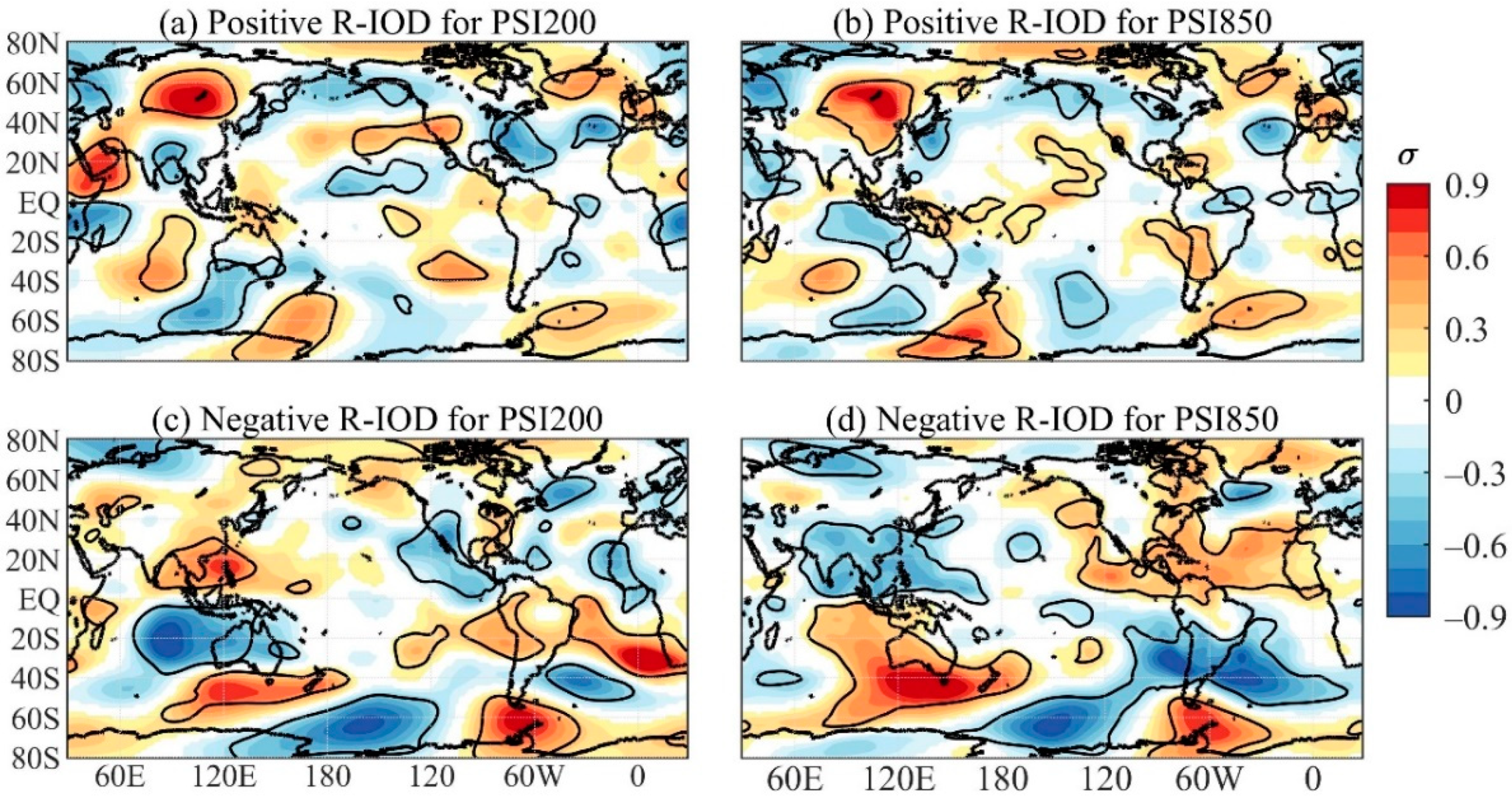
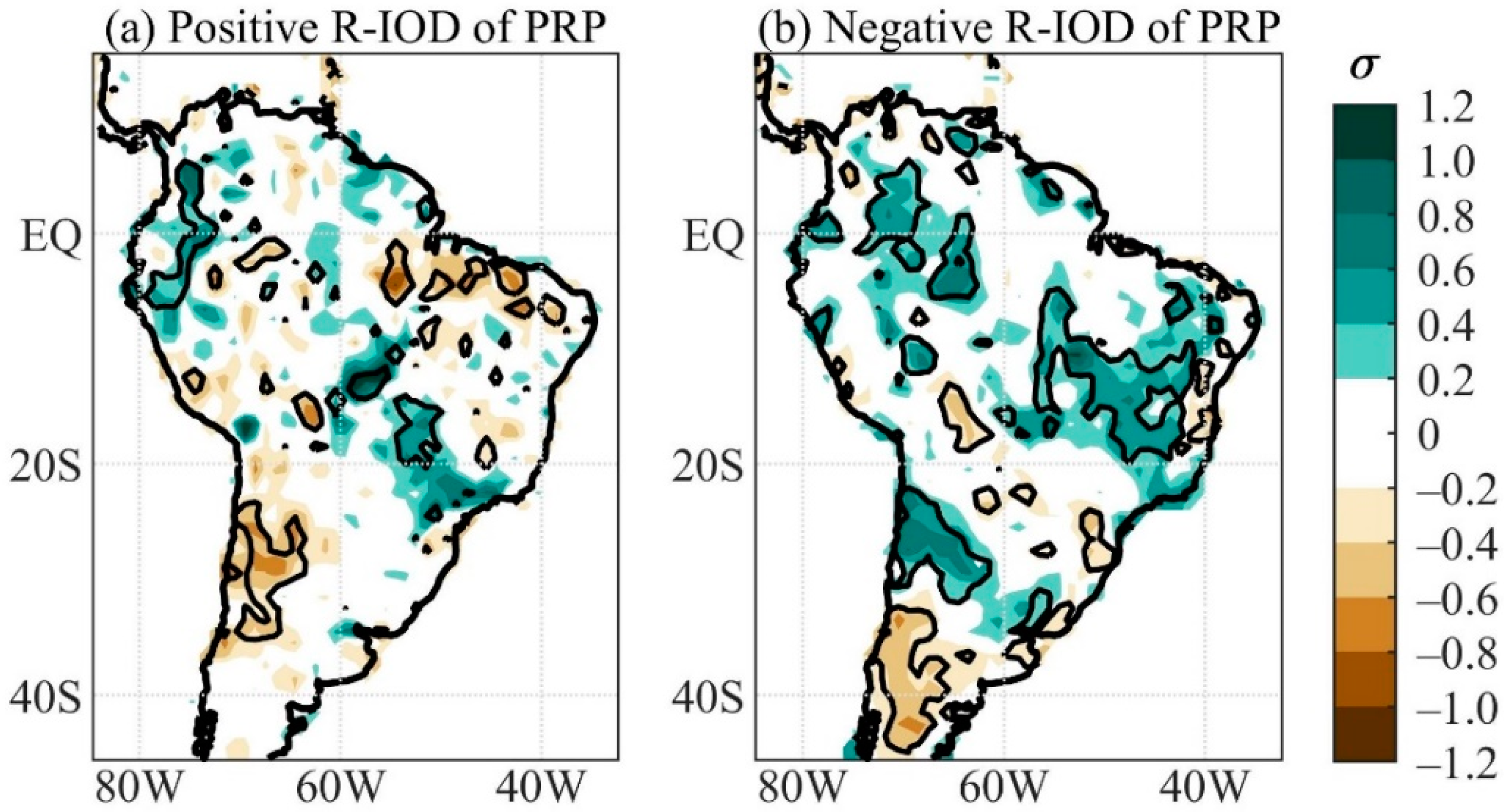

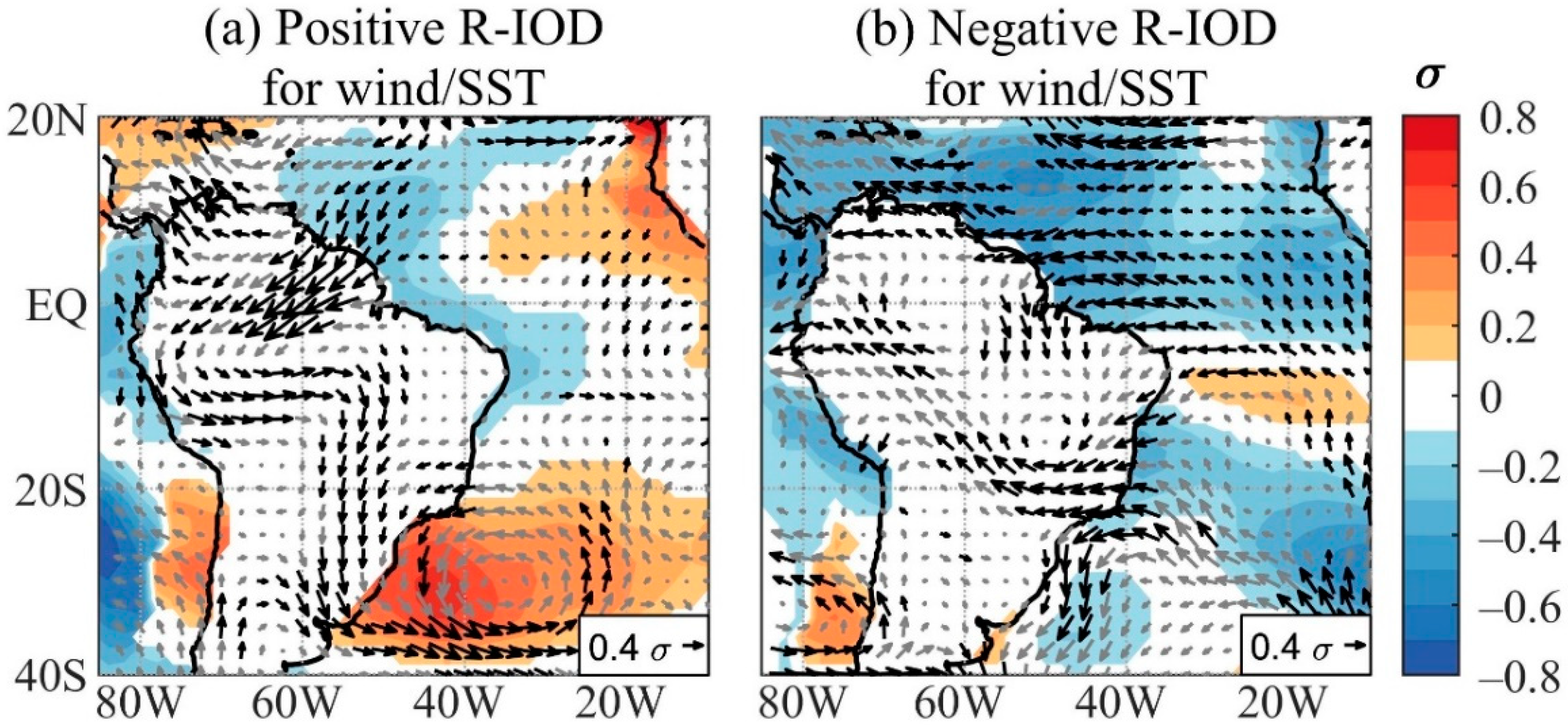
| Positive R-TPO | 1965, 1968, 1971, 1986, 1997, 2009, 2010 |
| Negative R-TPO | 1955, 1967, 1973, 1988, 1995, 2007, 2016 |
| Positive R-IOD | 1967, 1973, 1977, 1983, 1988, 1995, 2007 |
| Negative R-IOD | 1960, 1965, 1968, 1971, 1986, 1996, 2009 |
Publisher’s Note: MDPI stays neutral with regard to jurisdictional claims in published maps and institutional affiliations. |
© 2021 by the authors. Licensee MDPI, Basel, Switzerland. This article is an open access article distributed under the terms and conditions of the Creative Commons Attribution (CC BY) license (https://creativecommons.org/licenses/by/4.0/).
Share and Cite
Kayano, M.T.; Cerón, W.L.; Andreoli, R.V.; Souza, R.A.F.; Souza, I.P.; Canchala, T. El Niño-Southern Oscillation and Indian Ocean Dipole Modes: Their Effects on South American Rainfall during Austral Spring. Atmosphere 2021, 12, 1437. https://doi.org/10.3390/atmos12111437
Kayano MT, Cerón WL, Andreoli RV, Souza RAF, Souza IP, Canchala T. El Niño-Southern Oscillation and Indian Ocean Dipole Modes: Their Effects on South American Rainfall during Austral Spring. Atmosphere. 2021; 12(11):1437. https://doi.org/10.3390/atmos12111437
Chicago/Turabian StyleKayano, Mary T., Wilmar L. Cerón, Rita V. Andreoli, Rodrigo A. F. Souza, Itamara P. Souza, and Teresita Canchala. 2021. "El Niño-Southern Oscillation and Indian Ocean Dipole Modes: Their Effects on South American Rainfall during Austral Spring" Atmosphere 12, no. 11: 1437. https://doi.org/10.3390/atmos12111437
APA StyleKayano, M. T., Cerón, W. L., Andreoli, R. V., Souza, R. A. F., Souza, I. P., & Canchala, T. (2021). El Niño-Southern Oscillation and Indian Ocean Dipole Modes: Their Effects on South American Rainfall during Austral Spring. Atmosphere, 12(11), 1437. https://doi.org/10.3390/atmos12111437







